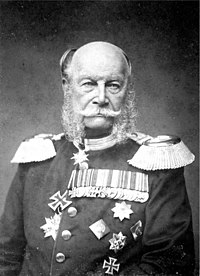Sideburns


Sideburns, sideboards,[1] or side whiskers are facial hair grown on the sides of the face, extending from the hairline to run parallel to or beyond the ears. The term sideburns is a 19th-century corruption of the original burnsides, named after American Civil War general Ambrose Burnside,[2] a man known for his unusual facial hairstyle that connected thick sideburns by way of a moustache, but left the chin clean-shaven.
Variations
Sideburns can be worn and grown in combination with other styles of facial hair, such as the moustache or goatee, but once they extend from ear to ear via the chin they cease to be sideburns and become a beard, chinstrap beard, or chin curtain. Indigenous men of Mexico, who shaved their heads and wore their sideburns long, as well as Colombians, who wear their sideburns long and typically do not have any other facial hair, are said to be wearing "balcarrotas", rarely seen in modern times, but prized in the sixteenth century as a mark of virile vanity and banned by the colonial authorities in New Spain, occasioning rioting in 1692.[3]
History

In ancient history, Alexander the Great is depicted with sideburns in a mosaic from Pompeii.
Following the eighteenth century, when European men west of Poland were universally clean-shaven, sideburns, like beards, began to increase in popularity during the Napoleonic period, at first among military men; the trend eventually made its way to Meiji Japan, in the first wave of Western fashion there. The return of facial hair in Western Europe began as a military fashion, at first inspired by the heroic sideburns sported by hussar regiments.
Following the fashion in Europe young South American criollos adopted sideburns. Many of the independence heroes of South America, including José de San Martín, Manuel Belgrano, Antonio José de Sucre, Bernardo O'Higgins, José Miguel Carrera, and Antonio Nariño had sideburns and are as such depicted on numerous paintings, coins and banknotes.
Nineteenth-century sideburns were often far more extravagant than those seen today, similar to what are now called mutton chops, but considerably more extreme. In period literature, "side whiskers" usually refers to this style, in which the whiskers hang well below the jaw line (see the picture of Wilhelm I, above right). As with beards, sideburns went quickly out of fashion in the early twentieth century. In World War I, in order to secure a seal on a gas mask, men had to be clean-shaven; this did not affect mustaches.
In 1936 President Roosevelt briefly experimented with sideburns on a yachting cruise, provoking laughter from wife Eleanor.[4] Sideburns made a comeback in the mid-1950s, when Marlon Brando's sideburns identified him as The Wild One (1953). Spurred by Elvis Presley, sideburns were sported by "hoods", "greasers", and "rockers" as an emblem of rebellious post-pubescent manliness by young men who scorned to be "Ivy League".[5]
The character Wolverine is usually depicted and portrayed with large sideburns, adding to his tough and aggressive persona. Sideburns gained new connotations in 1960s hippie subculture: the struggle of a New Jersey youth to wear sideburns to his public high school graduation made a newspaper article in 1967[6] and in the late 1960s and early 1970s among youth subcultures such as hippies and skinheads (usually to the jawline or shorter in the late 1960s).[7] Sideburns also became a symbol of the gay club scenes of San Francisco and Sydney, primarily Lambchops. Because of their multifarious history, sideburns may be seen as stuffily Victorian and ultra-conservative, a sign of rebelliousness,[8] or merely an artifact of current fashion.
Gallery
-
David Chubinashvili with "mutton-chops" sideburns
See also
References
- ^ "AskOxford". Retrieved 2007-06-27.
- ^ Goolrick, William K. Rebels Resurgent: Fredericksburg to Chancellorsville. p. 29.
- ^ Joaquín García Icazbalceta. "Vocabulario de mexicanismos : comprobado con ejemplos y comparado con los de otros paises hispano-americanos". Fundación Biblioteca Virtual Miguel de Cervantes. Retrieved March 1, 2013.
- ^ "President Grows crop of Sideburns: Mrs. Roosevelt Laughs Heartily as He Arrives at Campobello". The New York Times 28 July 1936. Retrieved 9 September 2008.
- ^ "Sideburns a la Presley Aren't Ivy; Dern of Penn Quits Track Rather Than Alter Appearance". The New York Times, 9 February 1957. Retrieved 9 September 2008.
- ^ "Youth With Sideburns Is Graduated in Jersey". The New York Times, 13 June 1967. Retrieved 9 September 2008.
- ^ http://www.styleforum.net/t/89027/mod-to-suedehead/10350#post_6089489
- ^ In the 1965 novel For Kicks by Dick Francis, one character advises another that, to go undercover as a disreputable stable lad, "Then, if I might suggest it, it would be a good idea for you to grow a couple of sideburns. It's surprising what a lot of distrust can be caused by an inch of extra hair in front of the ears!" Francis, Dick (1990). For Kicks. New York: Armchair Detective Library. p. 19. ISBN 0-922890-59-5.
External links
- Statues With Sideburns—A collection of statues of showing sideburns



